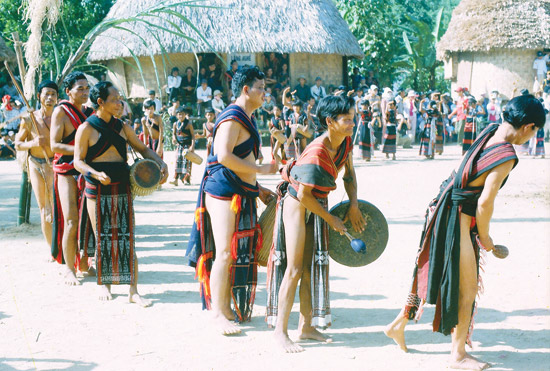(No.9, Vol.4,Oct-Nov 2014 Vietnam Heritage Magazine)


Tung tung dance for Co Tu boys and men
In the Co Tu language, ‘tung tung da da’ is a folk dance, a longstanding traditional ethnic dance of the Co Tu people in Quang Nam. ‘Tung tung’ is a dance that for Co Tu boys and men that re-enacts hunts for game and celebrations of victory in war. It embodies the elevated gallantry of the Co Tu people. The language of the dance suggests aspirations for hardy youths to rise to the perpetuation of their predecessors’ tradition and to maintain and protect their homeland of forests and mountains. When they dance, Co Tu men wear loincloths and pull over an embroidered woven upper garment. They drag their bare feet on the ground while they grasp shields, spears and scimitars with their hands; otherwise they firmly hold hands with a companion while spreading out both arms as they step and shout confidently, energetically, and courageously at the same time. They exhibit the strength of their village’s men and fearlessness before the harshness of nature or enemies who come to do harm. At the same time, they further manifest their confident inspirations as well as their love of life, home village, and the forests and mountains.
The Co Tu people express identity
and aspiration through dance
‘Da da’ is the Co Tu women’s dance, which originates from the movements of presenting oblations in the distant past. With such significance, the da da dance is reserved for Co Tu women and girls, who are naturally gentle, love their husbands and children, love the forests and mountains, and are quiet about everything, for the survival and development of the community. In order to display the da da dance, Co Tu women wear woven brocade dresses that bare the shoulders and have many vividly-coloured patterns. Around their necks, they wear beaded necklaces. The women extend both arms with the hands palm-up and fingers pointing backwards to express the joyous reception of the sacred. They look straight ahead, their mouths constantly smiling. They drag their bare feet on tiptoe around in counter-clockwise circles. When they dance, the women’s feet stand erect. Their arms both extend towards their heads with the palms pointing backwards as if supporting the sky, resembling a pair of buffalo horns that symbolize ‘the head of a buffalo bubbling below the water’s surface’ — a cultural nuance of many ethnic minorities as in the Co Tu sacrificial statues.

‘Tung tung da da’ is an amalgamated dance that shows the integration of men, boys, women and girls, as well as of yin and yang in a vast universe that occurs at a singular time and spirals in a fixed circle. ‘Tung tung da da’ has become a component that encourages the effort to produce and develop. ‘Tung tung da da’ is, moreover, a space that intimates the love between couples, village friends, the forests and the Co Tu people. ‘Tung tung da da’ seems to suggest the close-knit attachment of people with one another and a more natural way of life.
On 12 August, 2014, the National Heritage Council officially recognized the Quang Nam Co Tu style of ‘tung tung da da’ dance as a form of national immaterial culture heritage.

